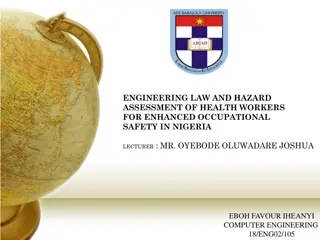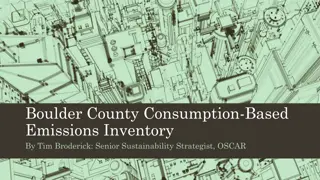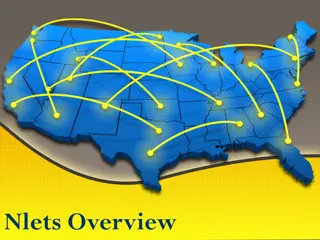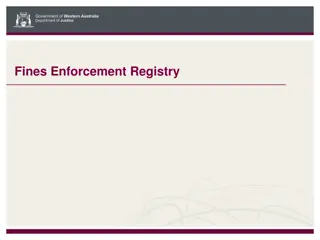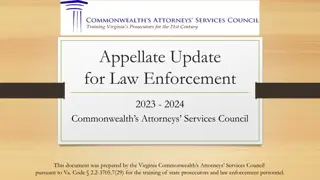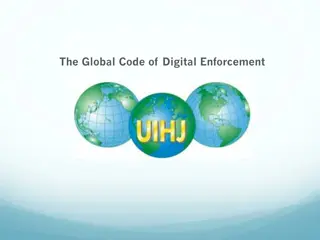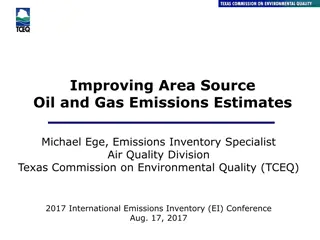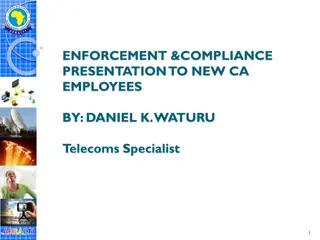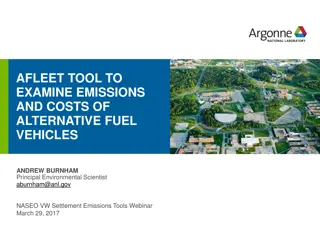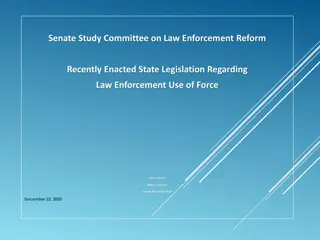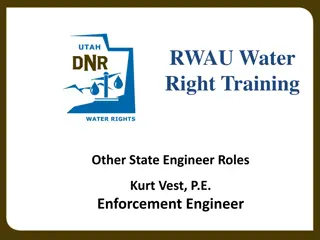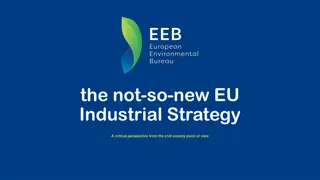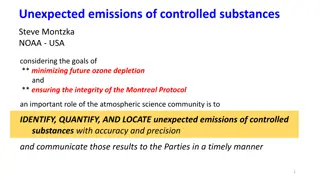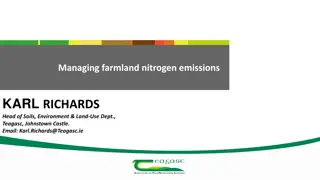Enforcement of EU and National Law on Industrial Emissions
This presentation delves into the enforcement of EU and national laws related to industrial emissions, focusing on inspections and penalties with a spotlight on Peter Vajda's insights. It covers applicable EU laws, overview of penalties in relation to environmental law, key enforcable provisions, inspections, and good practices for compliance.
Download Presentation

Please find below an Image/Link to download the presentation.
The content on the website is provided AS IS for your information and personal use only. It may not be sold, licensed, or shared on other websites without obtaining consent from the author.If you encounter any issues during the download, it is possible that the publisher has removed the file from their server.
You are allowed to download the files provided on this website for personal or commercial use, subject to the condition that they are used lawfully. All files are the property of their respective owners.
The content on the website is provided AS IS for your information and personal use only. It may not be sold, licensed, or shared on other websites without obtaining consent from the author.
E N D
Presentation Transcript
Enforcement of EU and national law on industrial emissions with focus on inspections and penalties Peter VAJDA
OUTLINE 1. APPLICABLE EU LAW ON INDUSTRIAL EMISSIONS 2. OVERVIEW OF PENALTIES PENALTIES IN RELATION TO ENVIRONMENTAL LAW EFFECTIVENESS, PROPORTIONALITY, DISSUASIVENESS 3. PENALTIES IN RELATION TO INDUSTRIAL EMISSIONS KEY ENFORCABLE PROVISIONS OF LEGISLATION ON INDUSTRIAL EMISSIONS ADMINISTRATIVE AND CRIMINAL SANCTIONS 4. INSPECTIONS 5. GOOD PRACTICES
OUTLINE 1. APPLICABLE EU LAW ON INDUSTRIAL EMISSIONS 2. OVERVIEW OF PENALTIES PENALTIES IN RELATION TO ENVIRONMENTAL LAW EFFECTIVENESS, PROPORTIONALITY, DISSUASIVENESS 3. PENALTIES IN RELATION TO INDUSTRIAL EMISSIONS KEY ENFORCABLE PROVISIONS OF LEGISLATION ON INDUSTRIAL EMISSIONS ADMINISTRATIVE AND CRIMINAL SANCTIONS 4. INSPECTIONS 5. GOOD PRACTICES
APPLICABLE EU LAW ON INDUSTRIAL EMISSIONS European Pollutant Release and Transfer Register (E-PRTR) Regulation 166/2006 IPPC Directive 2008/1/EC RELATION BETWEEN IPPC/IED Large Combustion Plants Directive 2001/80/EC Waste Incineration Directive 2000/76/EC Directive on the limitation of VOC emissions from solvents 1999/13/EC Directives related to the titanium-dioxide industry 78/186, 82/883, 92/112 Industrial Emissions Directive (IED) 2010/75/EU
APPLICABLE EU LAW ON INDUSTRIAL EMISSIONS IPPC DIRECTIVE Covers a wide range of industrial activities (energy sector, steel plants, chemical plants, cement kilns, intensive livestock, etc.) 50.000+ installations covered EU-wide Use of the best available techniques (see later) Obligation to hold a permit compliant to the Directive and covering the installation s emissions to air, (surface and ground-) water and to land Installation = stationary technical unit + directly associated activities Periodical reconsideration of the permits, substantial changes new permit Public participation, access to justice
APPLICABLE EU LAW ON INDUSTRIAL EMISSIONS BAT concept: the core of the IPPC Directive Best Available Techniques most effective in achieving a high general level of protection of the environment as a whole developed on a scale to be implemented in the relevant industrial sector, under economically and technically viable conditions, advantages balanced against costs the technology used and the way the installation is designed, built, maintained, operated and decommissioned
Installation level data (techniques, emissions, ...) BAT INFORMATION EXCHANGE Sevilla Process BREF with BAT conclusions
APPLICABLE EU LAW ON INDUSTRIAL EMISSIONS LCP DIRECTIVE Emission limit values for SO2, NOxand dust for plants with a rated thermal input of equal to or more than 50 MW More information in separate section WI DIRECTIVE Emission limit values and technical measures for waste incineration and waste co-incineration plants Rules on monitoring VOC DIRECTIVE Technical provisions on the use of organic solvents Chemical plants, smaller installations (dry cleaners)
APPLICABLE EU LAW ON INDUSTRIAL EMISSIONS IE DIRECTIVE Recasts the IPPC Directive and includes the sectoral directives within one framework Similar scope but with certain new activities Chapters/annexes with special technical provisions: LCPs (Chapter III / Annex V), waste incineration (Chapter IV / Annex VI), VOCs (Chapter V / Annex VII) BREFs BAT conclusions (Art. 14-15) BAT conclusions shall be the reference for setting permit conditions Provision on inspections (Art. 23) and penalties (Art. 79) First piece of EU environmental law with provisions on inspections (using the RMCEI as a reference)
OUTLINE 1. APPLICABLE EU LAW ON INDUSTRIAL EMISSIONS 2. OVERVIEW OF PENALTIES PENALTIES IN RELATION TO ENVIRONMENTAL LAW EFFECTIVENESS, PROPORTIONALITY, DISSUASIVENESS 3. PENALTIES IN RELATION TO INDUSTRIAL EMISSIONS KEY ENFORCABLE PROVISIONS OF LEGISLATION ON INDUSTRIAL EMISSIONS ADMINISTRATIVE AND CRIMINAL SANCTIONS 4. INSPECTIONS 5. GOOD PRACTICES
OVERVIEW OF PENALTIES PENALTIES IN RELATION TO ENVIRONMENTAL LAW Essential tools in the effective enforcement and implementation of EU & national environmental legislation Administrative and criminal sanctions Adoption of penalties as an enforcement mechanism for ensuring that legislation is complied with competence of the Member States differences Wide application outside the field of industrial emissions (e.g. nature protection, waste management) Discretionary application of penalties by Member States Market-based instruments ideally, enforcement should not be necessary, however, it is very important to safeguard a proper functioning of the market COM study (Oct 2011): Provisions on penalties related to legislation on industrial installations
OVERVIEW OF PENALTIES EFFECTIVENESS, PROPORTIONALITY, DISSUASIVENESS Current examples: Art. 16 LCP, Art. 19 WID, Art. 14 VOC Criteria undefined in current EU legal framework, COM study/workshop tried to develop certain lines of interpretation Effectiveness: penalties are capable of ensuring compliance with EU law and achieving the desired objective Proportionality: penalties adequately reflect the gravity of the violation and do not go beyond what is necessary to achieve the desired objective Dissuasiveness: penalties have a deterrent effect on the offender which should be prevented from repeating the offence and on the other potential offenders to commit the said offence
OVERVIEW OF PENALTIES EFFECTIVENESS, PROPORTIONALITY, DISSUASIVENESS inherent challenge: limited literature and case-law, divergence between MSs, three criteria closely interlinked Challenges arising from the definition: lack of empirical and evidential analysis of the penalties as applied in practice (application of criteria should be guided by the specific circumstances of individual cases and viewed within the wider context of the national enforcement systems within MSs) significant differences between national legal and institutional frameworks and practices and economic situations of each MS differences in the sanctions applied (e.g. administrative, criminal, quasi- criminal) and in the ranges and levels of penalties imposed no EU mandatory level of minimum or maximum fine for non-compliance with a particular legislative provision.
OUTLINE 1. APPLICABLE EU LAW ON INDUSTRIAL EMISSIONS 2. OVERVIEW OF PENALTIES PENALTIES IN RELATION TO ENVIRONMENTAL LAW EFFECTIVENESS, PROPORTIONALITY, DISSUASIVENESS 3. PENALTIES IN RELATION TO INDUSTRIAL EMISSIONS KEY ENFORCABLE PROVISIONS OF LEGISLATION ON INDUSTRIAL EMISSIONS ADMINISTRATIVE AND CRIMINAL SANCTIONS 4. INSPECTIONS 5. GOOD PRACTICES
PENALTIES IN RELATION TO INDUSTRIAL EMISSIONS KEY ENFORCABLE PROVISIONS IPPC Article 4 - No new installation shall be operated without a permit Article 5 - Existing installations shall have permits in accordance with the Directive by 30 October 2007 Article 6 - Applications for permits shall contain specific information listed Article 12(1) - Operators shall inform the competent authorities of any planned change in the operation Article 12(2) - Operators shall request a permit when they are planning substantial changes in their installation Article 14(a) - Operators shall comply with the conditions of a permit when operating the installation Article 14(b) - Operators shall regularly inform the competent authority of the results of monitoring of releases Article 14(c) - Operators shall afford the competent authority all necessary assistance with inspections
PENALTIES IN RELATION TO INDUSTRIAL EMISSIONS KEY ENFORCABLE PROVISIONS LCP Article 4(1) Operators of existing plants to comply with ELVs Article 4(2) Operators of new plants to comply with ELVs Article 4(4) Operators to submit each year to the competent authority a record of the used and unused time allowed for the plants remaining operational life. Article 7(1) In case of breakdown the operator must reduce or close down operations if a return to normal operation is not achieved within 24 hours, or operate the plant using low polluting fuels. In any case the CA shall be notified within 48 hours. Article 9 Waste gases shall be discharged in controlled fashion by means of a stack & in accordance with the licence. The stack height must be calculated as to safeguard health and the environment.
PENALTIES IN RELATION TO INDUSTRIAL EMISSIONS KEY ENFORCABLE PROVISIONS LCP (cont.) Article 10 Where a combustion plant is extended by at least 50 MW, ELVs set in part B of the Annexes shall apply to the new part & fixed in relation to the thermal capacity of the entire plant Article 13 The operator shall inform the CA [ ] about results of continuous measurements, the checking of measuring equipment, & all individual & other measurements carried out to assess compliance.
PENALTIES IN RELATION TO INDUSTRIAL EMISSIONS KEY ENFORCABLE PROVISIONS WID (examples) Article 4(1) No incineration or co-incineration plant shall operate without a permit. Article 4(2) Applications for permits shall contain a description of specific measures. Article 5(1) Operator shall take all necessary precautions concerning the delivery and reception of waste in order to prevent or to limit negative effects on human health and environment. Article 7 Requires incineration plants to be designed, equipped, built and operated in such a way that they comply with the air emission limit values set in this article. Article 13 (2) In case of breakdown, the operator shall reduce or close down operations as soon as practicable until normal operations can be restored.
PENALTIES IN RELATION TO INDUSTRIAL EMISSIONS KEY ENFORCABLE PROVISIONS SUMMARY (KEY OBLIGATIONS) Obligation 1: to apply for a permit for existing and new installations Obligation 2: to supply information for application for permits Obligation 3: to notify the competent authority of any changes in the operation of an installation Obligation 4: to comply with the conditions set in the permit or mandatory ELVs
PENALTIES IN RELATION TO INDUSTRIAL EMISSIONS ADMINISTRATIVE AND CRIMINAL SANCTIONS APPROACH No general practice regarding industrial installations amongst MSs Common law countries no administrative sanctions in place for offences (UK: new legislation of 2010 civil sanctions ) Parallel use of both systems: Denmark, Greece, Hungary, Netherlands, Poland, Portugal, Romania, Czech Republic, Sweden Administrative and criminal sanctions cannot be applied simultaniously: Austria, Belgium, Germany, Slovakia, Spain ( non bis in idem ) Differences between centralized and federal states (e.g. in Spain, several Autonomous Communities - but not all of them - have established their own sanctioning regime for the infringement of environmental legislation) Distinction between natural and legal persons
PENALTIES IN RELATION TO INDUSTRIAL EMISSIONS ADMINISTRATIVE SANCTIONS FINANCIAL PENALTIES Main tool: fines (amount may vary significantly amongst the different MSs) LV: 2,134 PT: 2.5m General practice: legislation provides a range of fines, depending mainly on severity of the offence and its effect on the environment.
PENALTIES IN RELATION TO INDUSTRIAL EMISSIONS ADMINISTRATIVE SANCTIONS ADDITIONAL/OTHER ADMINISTRATIVE MEASURES Examples: restriction, suspension or prohibition/ban of the activity (in general); cancellation of the licence or restriction of its terms; seizure of tools, machinery and equipment; suspension of the right to obtain subsidies or other benefits issued by national or European public authorities or services; loss of tax benefits, credit benefits and credit financing acquired prior to the offence; imposition of rectification or corrective measures on the operator; closure of the installation concerned.
PENALTIES IN RELATION TO INDUSTRIAL EMISSIONS QUASI-CRIMINAL SANCTIONS Not applied generally; Misdemeanours , petty offences ; Similar penalties to criminal sanctions with a simplified procedure; First instance are handled by the administrative authorities rather than by the judicial system; In certain cases, it is applicable to natural persons only (Hungary); Austria, Germany, Estonia: quasi-criminal sanctions instead of administrative sanctions (alongside with criminal sanctions and administrative enforcement measures).
PENALTIES IN RELATION TO INDUSTRIAL EMISSIONS CRIMINAL SANCTIONS In the vast majority of Member States (except e.g. Portugal), usually combined with sectoral legislation; Primary penalties: imprisonment, fine (with wide variations, illustrative example: AT and PL for breach of key obligations 1&4) PL: 1,250 AT: 1.8m PL: 30 days AT: 5 years
PENALTIES IN RELATION TO INDUSTRIAL EMISSIONS CRIMINAL SANCTIONS Combination of criminal sanctions is possible in most MSs; Daily fines: Austria, Germany ( 4 to 5000); Highest criminal penalty: Ireland maximum penalty for all four obligations is 15,000,000 / 15 years imprisonment. In Belgium (Wallonia), the maximums are 10,000,000 / 15 years imprisonment, respectively; Key Obligation 1 and 4 most penalized amongst the MSs; Key Obligation 2 least penalized.
OUTLINE 1. APPLICABLE EU LAW ON INDUSTRIAL EMISSIONS 2. OVERVIEW OF PENALTIES PENALTIES IN RELATION TO ENVIRONMENTAL LAW EFFECTIVENESS, PROPORTIONALITY, DISSUASIVENESS 3. PENALTIES IN RELATION TO INDUSTRIAL EMISSIONS KEY ENFORCABLE PROVISIONS OF LEGISLATION ON INDUSTRIAL EMISSIONS ADMINISTRATIVE AND CRIMINAL SANCTIONS 4. INSPECTIONS 5. GOOD PRACTICES
INSPECTIONS RELEVANCE FOR PENALTIES Main tool to find out compliance with Key Obligation 4 Clarify discrepancies between submitted documentation and real life Competent authority can be different for inspections and penalties No harmonized legislation at EU level IPPC Article 14(c) Operators shall afford the competent authority all necessary assistance with inspections (KO 4) RMCEI (2001)
INSPECTIONS INSPECTIONS IN THE IED Proposal made extensive use of the RMCEI and the accumulated experience after its adoption; Inspection plans: all installations should be covered by an environmental inspection plan at national, regional or local level, MS shall ensure that this plan is regularly reviewed and, where appropriate, updated; Harmonized criteria for the elements of the inspection plans; System of routine inspections (based on the inspection plans), risk-based approach for frequency; Inspection reports shall be made available to the public after a consultation period with the operator
OUTLINE 1. APPLICABLE EU LAW ON INDUSTRIAL EMISSIONS 2. OVERVIEW OF PENALTIES PENALTIES IN RELATION TO ENVIRONMENTAL LAW EFFECTIVENESS, PROPORTIONALITY, DISSUASIVENESS 3. PENALTIES IN RELATION TO INDUSTRIAL EMISSIONS KEY ENFORCABLE PROVISIONS OF LEGISLATION ON INDUSTRIAL EMISSIONS ADMINISTRATIVE AND CRIMINAL SANCTIONS 4. INSPECTIONS 5. GOOD PRACTICES
GOOD PRACTICES GOOD PRACTICES Examples of successful approaches to enforcement Study lists a number of examples (administrative, criminal) from 7 selected MSs No sorcerer s stone which could be applied in all MSs (effectiveness, proportionality and dissuasiveness may have completely different meanings and contributing factors in different MSs/cultures)
THANK YOU FOR YOUR ATTENTION! CONTACT peter.vajda@energy-community.org






